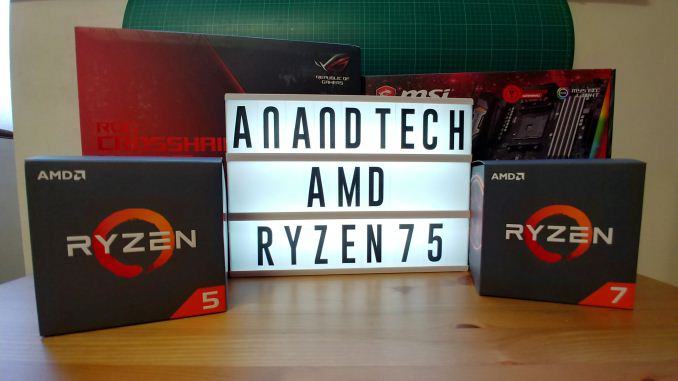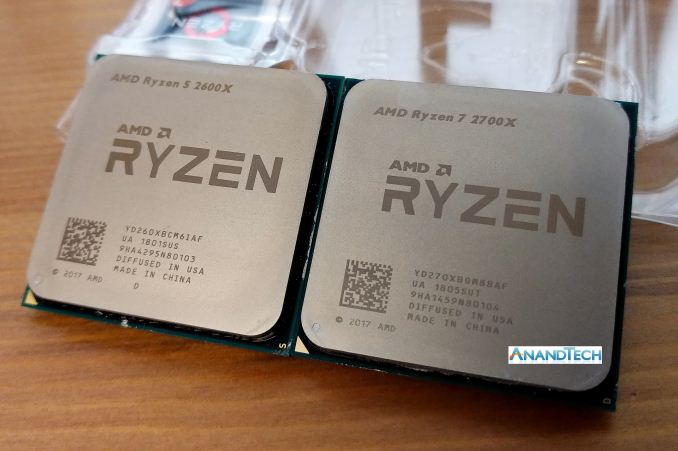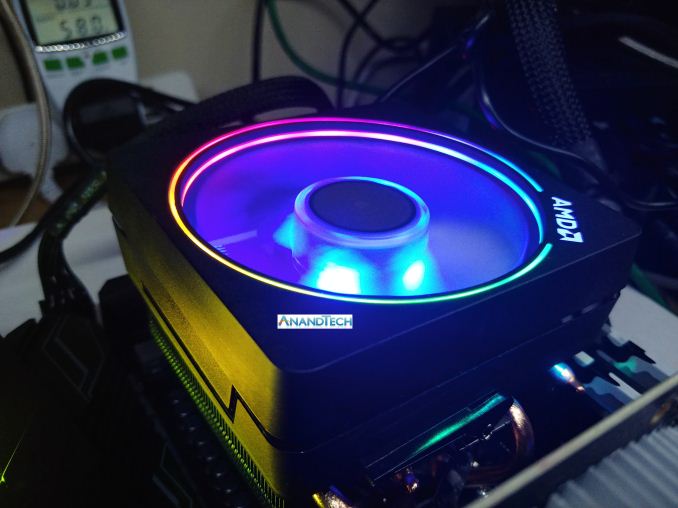The AMD 2nd Gen Ryzen Deep Dive: The 2700X, 2700, 2600X, and 2600 Tested
by Ian Cutress on April 19, 2018 9:00 AM EST
With 2017 finished, and Ryzen being very successful for AMD, the inevitable question was due: what happens next? Early in 2018, the plans were laid bare: a second generation Ryzen processor was set to come in mid-year, followed by a second generation Threadripper, using GlobalFoundries’ 12nm process. This is not AMD’s next big microarchitecture, which we know is called Zen 2 on 7nm, but an opportunity to launch a wave of components with minor improvements and take advantage of a manufacturing process that gives more frequency and more performance. Today AMD is launching four CPUs, and we have tested them all.
Updates
- (4/21) Some of our results, initially thought due to Spectre/Meltdown patches, were not in line with others. Testing audit was started.
- (4/25) Our extensive internal audit showed reasons for the differences, as documented in detail in this follow-up article. In short, an issue with a non-standard use timers on Windows was causing the performance of both AMD and Intel processors to dip, particularly impacting the latter.
- (5/2) Benchmark results have been updated.
- (5/22) X470 Motherboard. StoreMI, and Power Analysis pages updated.
- (5/26) Conclusion Updated, Performance Per Dollar graphs added.
Straight To The Scene: The New CPUs
For readers that only want one piece of information, this is it: AMD is launching the Ryzen 7 2700X, the Ryzen 7 2700, the Ryzen 5 2600X, and the Ryzen 5 2600.
| AMD Ryzen 2000-Series CPUss | ||||
| Ryzen 7 2700X | Ryzen 7 2700 | Ryzen 5 2600X | Ryzen 5 2600 | |
| CPU Cores/Threads | 8 / 16 | 8 / 16 | 6 / 12 | 6 / 12 |
| Base CPU Frequency | 3.7 GHz | 3.2 GHz | 3.6 GHz | 3.4 GHz |
| Turbo CPU Frequency | 4.3 GHz | 4.1 GHz | 4.2 GHz | 3.9 GHz |
| TDP @ Base Frequency | 105 W | 65 W | 95 W | 65 W |
| L1 Cache | I: 64K. D: 32K | I: 64K. D: 32K | I: 64K. D: 32K | I: 64K. D: 32K |
| L2 Cache | 512 KB/core | 512 KB/core | 512 KB/core | 512 KB/core |
| L3 Cache | 16 MB | 16 MB | 16 MB | 16 MB |
| DRAM Support | DDR4-2933 Dual Channel |
DDR4-2933 Dual Channel |
DDR4-2933 Dual Channel |
DDR4-2933 Dual Channel |
| PCIe Lanes (CPU) | 16 Free + 4 NVMe | 16 Free + 4 NVMe | 16 Free + 4 NVMe | 16 Free + 4 NVMe |
| Price | $329 | $299 | $229 | $199 |
| Bundled Cooler | AMD Prism RGB | AMD Spire RGB | AMD Spire | AMD Stealth |
The Ryzen 7 2700X takes over the top spot from the Ryzen 7 1800X, and for an extra 10 W in TDP will provide a base frequency of 3.7 GHz and a turbo frequency of 4.3 GHz on its eight cores, with simultaneous multi-threading. This is an extra +100 MHz and +300 MHz respectively, going above the average limits of the 1800X when overclocked.
The 2700X also reduces the top cost for the best AM4 Ryzen processor: when launched, the 1800X was set at $499, without a bundled cooler, and was recently dropped to $349 as a price-competitor to Intel’s most powerful mainstream processor. The 2700X undercuts both, by being listed at a suggested e-tail price of $329, and is bundled with the best stock cooler in the business: AMD’s Wraith Prism RGB. AMD is attempting to hit all the targets: aggressive pricing, top performance, and best value, all in one go.
The Ryzen 5 2600X is the six-core option, also with an aggressive frequency strategy: 3.6 GHz base and 4.2 GHz turbo. At a 95W TDP and a suggested retail price of $229, it comes bundled with AMD’s Wraith Spire cooler, which again is an impressive stock cooler.
The Ryzen 7 2700 and Ryzen 5 2600 are the 65W versions of the X counterparts, offering near-similar frequencies for $30 less. All the CPUs will support dual-channel DDR4-2933 memory, up from the DDR4-2666 memory support of the 2017 Ryzen processors. One of the big changes is that now every processor comes with a bundled stock cooler, ranging from the Silent 65W Stealth models up to the big Prism RGB, all of which are easily sufficient for good turbo performance.
AMD’s intended AM4 Ryzen product line is now going to look like this:
| AMD Ryzen Product Stacks & Launch Prices | |||
| Ryzen 1000 (2017) | Ryzen 2000 (2018) | ||
| Ryzen 7 1800X | $499 | Ryzen 7 2700X | $329 |
| Ryzen 7 1700X | $399 | ||
| Ryzen 7 1700 | $329 | Ryzen 7 2700 | $299 |
| Ryzen 5 1600X | $249 | Ryzen 5 2600X | $229 |
| Ryzen 5 1600 | $219 | Ryzen 5 2600 | $199 |
| Ryzen 5 1500X | $189 | Ryzen 5 1500X | $159 |
| Ryzen 5 1400 | $169 | Ryzen 5 2400G | $169 |
| Ryzen 3 1300X | $129 | Ryzen 3 1300X | $114 |
| Ryzen 3 1200 | $109 | Ryzen 3 2200G | $99 |
At the top, the 2700X takes over from both the 1700X and 1800X. Rather than having three Ryzen 7 CPUs in the market for this generation, AMD examined its product line and opted on two, perhaps based on sales figures. As seen in this review, the 2700X is already pushing the silicon process to the limit, so there is not much headroom to go above this product for a new model in the future.
The full list ends up being a mix of Ryzen 2000-series CPUs (the new ones), Ryzen 2000-series APUs, and a pair of Ryzen 1000-series. We already examined the APUs in great detail in the past few weeks, showing that they directly replaced some of the original first-generation parts very easily. So far the four new 2000-series will sit at the top of the pile, however AMD’s strategy is often to drip feed its new parts, so we might see some more 2000-series as time goes on.
The Other Information From Today’s Launch
No launch is complete without talking about the features. AMD is using GlobalFoundries’ 12nm manufacturing process which has obvious on-paper benefits, however there are a number of internal firmware adjustments to touch upon, updated features and roles for AMD’s Precision Boost and XFR technologies that can have direct impacts on performance, a new chipset (along with 30+ motherboards) to run alongside the current offerings, and also new/renamed features such StoreMI. We also want to examine how these new products fit into AMD’s longer term plans and whether they are on track.
We’ll cover these in the next few pages, as well as the results from our testing.
- Talking 12nm: GlobalFoundries and Extra Performance
- Improvements to the Cache Hierarchy: +3% IPC and +10% Overall
- Precision Boost 2: Getting More Hertz Across The Board
- XFR2: A Dynamic Response to Cooling
- New X470 Chipset and Motherboards: A Focus on Power
- StoreMI: The Way To A Faster JBOD
- Power Analysis
- Our CPU Benchmarking Results
- Our Gaming CPU Benchmarking Results
- Conclusions
AMD’s Ryzen 2000 Competition: Intel’s Coffee Lake
As part of today’s launch, AMD went into extensive benchmarking detail about its new chips. It was abundantly clear from the data provided that these new processors are aimed squarely at Intel’s most recent mainstream processors: Coffee Lake. This is in contrast to when the Ryzen 1000-series was launched last year, when the octo-core Ryzen 7 1800X was compared against an 8-core Broadwell-E: in the interim Intel has updated its mainstream processor line to six-cores with high frequencies.
As a result, AMD is suggesting to compare the Ryzen 7 2700X against the Core i7-8700K and the Ryzen 5 2600X against the Core i5-8500K. This is significant – now both of the main x86 players in the processor market are keen to pit their most recent products against each other in a head to head battle. This hasn’t really happened like this for a number of generations. However, certain metrics will still run true as to the launch last year:
- Intel is expected to have a frequency and IPC advantage
- AMD’s counter is to come close on frequency and offer more cores at the same price
It is easy for AMD to wave the multi-threaded crown with its internal testing, however the single thread performance is still a little behind. A number of the new features with the Ryzen 2000-series are designed to help this: slightly higher IPC, higher frequencies, a higher TDP, and a better dynamic frequency boost model. We will cover these over the next few pages.
| Comparison: Ryzen 7 2700X vs Core i7-8700K | ||
| AMD Ryzen 7 2700X |
Features | Intel Core i7-8700K |
| 8 / 16 | Cores/Threads | 6 / 12 |
| 3.7 / 4.3 GHz | Base/Turbo | 3.7 / 4.7 |
| 16 (Free) + 4 (NVMe) | PCIe 3.0 Lanes | 16 (Free) |
| 512 KB/core | L2 Cache | 256 KB/core |
| 16 MB | L3 Cache | 12 MB |
| 105 W | TDP | 95 W |
| $329 | Price (List) | $349 |
Frequencies and core counts are one part of the equation, though the way that AMD and Intel have different cache models will also play a significant part. One of the things we will see in this analysis is the comparative cache metrics, as well as the tuning AMD has done to close the gap. For pricing, AMD has put the Ryzen 7 2700X below the i7-8700K, as well as bundling the Wraith Prism RGB stock cooler which easily replaces any $30-40 cooler, saving the user some money.
| Comparison: Ryzen 5 2600X vs Core i5-8600K | ||
| AMD Ryzen 5 2600X |
Features | Intel Core i5-8600K |
| 6 / 12 | Cores/Threads | 6 / 6 |
| 3.6 / 4.2 GHz | Base/Turbo | 3.6 / 4.3 |
| 16 (Free) + 4 (NVMe) | PCIe 3.0 Lanes | 16 (Free) |
| 512 KB/core | L2 Cache | 256 KB/core |
| 16 MB | L3 Cache | 9 MB |
| 95 W | TDP | 95 W |
| $229 | Price (List) | $239 |
The Ryzen 5 2600X comparison with the Core i5-8600K is much closer than the higher-end parts. These components share core counts, although the Ryzen 5 has double the threads. For any multithreaded workload that can take advantage of simultaneous multithreading is likely to pull ahead. The Core i5-8600K is slightly ahead in core frequency, and is expected to have an IPC advantage as well. Again, AMD bundles the CPU with a good stock cooler, whereas Intel’s offering is poor-to-nil.
Overall, AMD is claiming that its high-end processors will come in within 1-2% of the competition at 1440p gaming, but give +20% in ‘creative performance’. We’ve got a few ways to test this.













545 Comments
View All Comments
John_M - Monday, April 23, 2018 - link
What edition of Windows 10 to typical gamers use and why?johnsmith222 - Monday, April 23, 2018 - link
In the meantime we have a lot benches to analyse :)Sum of web benches:
https://www.3dcenter.org/news/ryzen-2000-launchrev...
oRAirwolf - Monday, April 23, 2018 - link
I would really like to see some storage bench mark to compare pre and post Spectre/Meltdown patching of Intel CPUs as well as an apples-to-apples comparison of nvme storage performance compared to an Intel 8700k.Silma - Monday, April 23, 2018 - link
It's really hard to generalize on why people purchase the processors they do.I met a guy online with an over the top, super expensive computer. His sole purpose seems to be the first in the online tests and he will spend hours fine tuning the overclocking and whatnot.
Another guy mostly playing D3 purchased a 3K euro computer, which is absolutely over the top for what he plays/does. His reasoning is, I change my computer every 10 years, so when i do, I want the best components.
In my opinion, for most people without special needs (YouTube encoding, 3D rendering and whatnot), most processors have been good enough for years, and there is no reason to invest a lot in a processor when money is much better spent in an x4 PCIe SSD where you'll instantly feel the difference vs a hard drive or a medium quality SSD.
To me, power consumption and noise of processor as well as graphic card is a consideration at least as important as price.
The sole reason I would change processor today would be to get a fully Thunderbolt 3 compatible system, since the first TB3 audio interfaces are slowly coming to market.
Then again, I'm sure many people will have other priorities and reasons for purchasing their processors.
Targon - Monday, April 23, 2018 - link
Many of these high end systems are overpriced, or they come with components that are not worth it for what is being done. With that being said, going for a higher end CPU does make sense for those looking to keep their systems for a long time. Video cards and storage are areas that people should pay close attention to when it comes to price.NVMe drives are VERY expensive if you go up to the 1TB level, so spending that sort of money doesn't make sense when the prices will drop in the next two years. A 250-500GB NVMe drive would make more sense when combined with a traditional hard drive for additional storage. Video cards are also at a premium right now, as is RAM. If the system were purchased back in April of 2017, then yea, not too horrible to go for 32GB of RAM back then, but now, I'd stick with 16GB of RAM due to the prices being so much higher than they were.
For desktops, Thunderbolt isn't all that amazing when you can add a video or sound card to the system that will do what you want it to. Laptops are another story, and you need to pick and choose your priorities.
Flying Aardvark - Monday, April 23, 2018 - link
That's if you're short on money. I don't spend much extra other than vacations & eating very well. So when I upgrade, which is every 5 to 10 years, I buy the best available like Silma. I have a 1TB 960 Pro for that reason, it was $650 and I didn't think twice about it. I need the most reliable, fastest drive at the time. The 960 Pro is a MLC memory configuration, I've always used higher end MLC drives and they've served me very well.I'm not waiting a year or two, when I have over $100,000 sitting in my bank account doing nothing. What's the point, it's just $650. Same goes for the rest of my computer, which I only own/maintain one of.
Not everyone is a child or someone who doesn't spend the majority of their time progressing their careers so they can make more money. The price consideration is not the end-all, ultimate rule on hardware for every single consumer.
mapesdhs - Monday, April 23, 2018 - link
Indeed, though I guarantee some here will react poorly at the notion of someone who can make such a purchasing decision. :) Sometimes the best makes perfect sense, and if one can afford it, then why not.Kaihekoa - Monday, April 23, 2018 - link
Why are Anand's gaming numbers showing the 2700X beating all Intel CPUs when every other reviewer still shows the 8700K/7700K still being the best gaming CPUs?Flying Aardvark - Monday, April 23, 2018 - link
TechRadar & the wccftech preview has the same results. If you have been following Spectre as I have, you would've seen even users find this result. See the top comments here. https://np.reddit.com/r/pcmasterrace/comments/7obo...AT, TR & WCCF's results are accurate. Many reasons for this.
- Many reviewers used the old Ryzen balanced power setting which cripples the 2700X
- Disallowed the motherboard settings that push the chip over TDP
- Fully patched as possible for Spectre v1 & v2, which cripples Intel up to 50% in IO heavy tasks (streaming textures for games that do so).
There is naturally, lots of resistance to the fact that AMD is dominating. It's over for now, time for people to just admit it, they got screwed if they don't have Ryzen. Or at least, bought the inferior product.
mapesdhs - Monday, April 23, 2018 - link
I don't think those posting so much venom about the results will change their minds until AMD releases something that really is just right out the gate blatantly faster, including for IPC. Another year or two and I think that will happen.